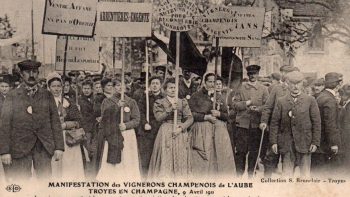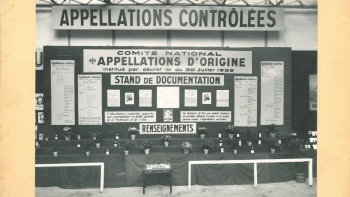90 years exhibition: The origins of INAO, the invention of the AOC system
The AOC system has its roots in a long history of crises and transformations in the French wine industry. The phylloxera crisis of the early 19th century devastated the vineyards and marked the beginning of a series of upheavals. Several unsuccessful attempts were made to define and protect the notion of origin in order to protect quality wines and combat fraud.
The creation of the Comité National des Appellations d'Origine, forerunner of the INAO, helped to meet the challenges facing the sector. Thanks to an original form of governance enabling professionals themselves to define the orientations that concern them, in liaison with the State, it will enable the stabilization and success of the AOC system.

THE ORIGIN OF AOC WINES: A RESPONSE TO THE WINE CRISIS
The context in which the AOC system was set up was marked by several key elements, first and foremost a crisis of confidence linked to the proliferation of fraud from the early 20th century onwards, following the development of phylloxera in the vineyards. Indeed, faced with the lack of supply caused by phylloxera on the market, frauds at renowned vineyards multiplied.
In addition, the economic crisis of the 1930s, coupled with the closure of major international markets, amplified the difficulties faced by the French wine industry.
In this context, the laws of 1905, 1919 and 1927 laid the foundations for the protection of Appellations d'Origine. The 1935 decree-law, which created the Comité National des Appellations d'Origine (CNAO) and the new category of "Appellation d'Origine Contrôlée" (AOC), broke the deadlock. The creation of the CNAO is the result of a joint effort between local players (winegrowers' unions, fine wine producers, etc.) and national authorities (government, administration, etc.) to establish a new legal and institutional framework for the definition, governance and protection of Appellations d'Origine. The aim is to guarantee the conditions under which these wines are produced, beyond the simple indication of origin. It also means involving operators more strongly in decision-making, so that they can take their destiny into their own hands, in consultation with the State.
INAO'S FOUNDING MISSIONS
The CNAO is thus created, supported by a network of recognized and committed professionals. It became the Institut National des Appellations d'Origine (INAO) in 1947, whose missions are to define and protect appellations of origin. With the work carried out by the judicial tribunals, production areas are precisely delimited and production conditions are systematically defined for each appellation, which had previously been optional for applicants.

Fighting fraud
The system sets strict standards and monitors their application to eradicate fraudulent practices.
Promoting through origin
The AOC, through technical and legal expertise, precisely frames the notion of origin with the aim of enhancing the value of fine wines and thus strengthening their position on national and international markets.
Structuring the wine sector
The AOC system organizes and structures the wine sector, and involves the various players (producers, merchants, public institutions) in a regulated and controlled framework, where the appellation of origin is now a public and necessarily collective good.
Exhibition summary: INAO, 90 years at the service of French agriculture
Further information
- Histoire
- 1905-1935 : the beginnings of appellations d'origine : a response to the food and wine crises
- 1935-1970: the advent of INAO and the creation of Appellations d'Origine Contrôlées
- 1960-1990: the creation of Label Rouge and the recognition of Organic Agriculture
- 1990-2000: the development of SIQOs in Europe and the extension of INAO's missions
- 2000 to today: INAO, a policy tool for promoting French agricultural products
- Key dates for official signs of quality and origin (SIQO) and INAO
Download the exhibition panel
Exposition 90 ans - Panneau 4
« AUX ORIGINES DE LA CRÉATION DE L’INAO, L’INVENTION DU SYSTÈME DES AOC »
